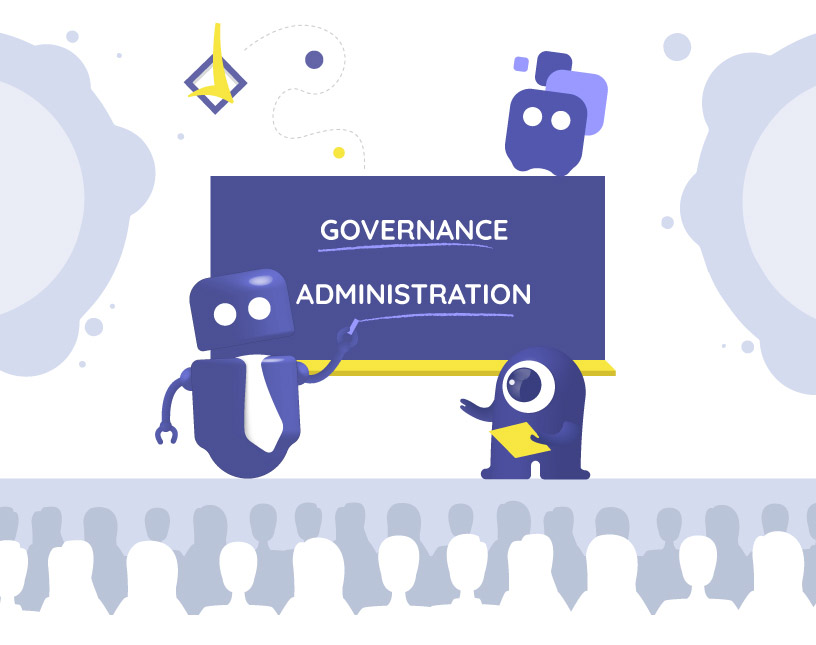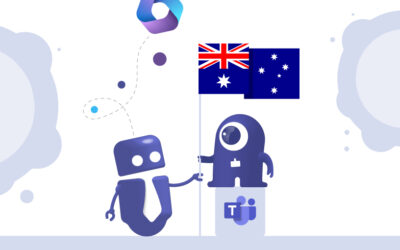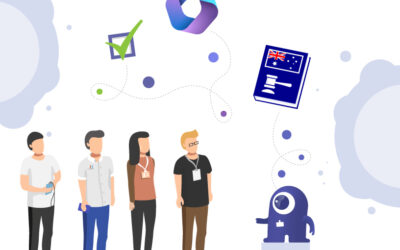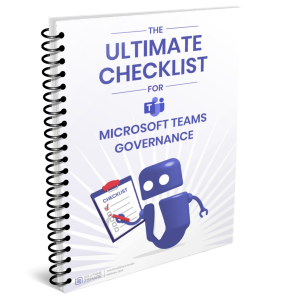Teams Governance vs. Teams Administration
Microsoft Teams governance and Microsoft Teams administration are two very different but related concepts. Both are important for maintaining the security and functionality of the platform.
In this blog post, we will take a look at the different elements of Teams governance vs. Teams administration. Which topics are the most important? Which parts should organizations establish before implementing Microsoft Teams?
First, when it comes to managing and securing your organization’s Microsoft Teams environment, governance is key. Governance encompasses the policies, procedures, and controls that keep your Teams platform running smoothly and securely. This includes elements such as defining who has access to your Teams environment and at what level, managing and securing the data shared within Teams, ensuring compliance with legal and regulatory requirements, managing and securing the devices that access Teams, managing and securing access to Teams for external users, monitoring and reporting on Teams usage, managing and controlling changes to Teams and training and encouraging adoption throughout the organization.
By implementing effective governance measures, you can ensure that your Teams environment is being used in a secure and compliant manner, and that it aligns with your organization’s overall goals and objectives.
While governance sets the foundation for a secure and compliant Microsoft Teams environment, administration is the day-to-day work that keeps your teams platform running smoothly. As a Teams administrator, you will be responsible for tasks such as creating and managing teams and channels, assigning roles and permissions, configuring settings and integrations, monitoring and troubleshooting issues, and implementing updates and new features.
This can include managing user accounts, setting up channels and teams, configuring settings and options, troubleshooting technical issues and implementing updates and new features. The ultimate goal of Teams administration is to ensure that the platform is running efficiently and that users have the resources they need to be productive. With proper administration, you can ensure that your teams environment is always running at its best.
What are the key elements of Teams governance?
1. Access control
Defining who can access and use Microsoft Teams, and what level of access they have.
2. Data governance
Managing and securing the data shared within MS Teams, such as chat messages, files, and conversations.
3. Compliance
Ensuring that Teams is being used in compliance with legal, regulatory, and organizational requirements.
4. Device management
Managing and securing the devices that access Microsoft Teams, such as laptops, smartphones, and tablets.
5. Governance of external access
Managing and securing access to MS Teams for external users, such as partners and suppliers. For more information on how to keep your Teams environment secure and manage MS Teams guests, take a look at External User Manager.
6. Auditing and reporting
Monitoring and reporting on Teams usage, such as who is using it and how it is being used.
7. Change management
Managing and controlling changes to Microsoft Teams, such as updates and new features.
8. Training and adoption
Ensuring that users are trained on how to use Teams and encouraging its adoption throughout the organization.
The most important parts of Teams governance
The most important element of Teams governance will depend on the specific needs and priorities of an organization. However, in general, data governance and compliance are considered to be among the most important elements of Teams governance.
Data governance refers to the management and security of data shared within Microsoft Teams, such as chat messages, files, and conversations. It is important because it ensures that sensitive and confidential information is protected and that data is used and shared in compliance with organizational policies.
Compliance is also critical because it ensures that Microsoft Teams is being used in compliance with legal, regulatory, and organizational requirements, such as data privacy laws, industry regulations, and company policies. Noncompliance can result in significant financial and reputational damage to an organization.
Additionally, access control is also crucial as it defines who can access and use Teams, and what level of access they have. This can prevent unauthorized access to sensitive information and ensure that only authorized personnel can access and use the platform.
In summary, data governance and compliance are often the most important elements of Microsoft Teams governance as they protect sensitive data and ensure that the platform is used in compliance with legal and organizational requirements. However, the other elements such as device management, training and adoption, and change management also play an important role in maintaining the security and functionality of the platform.
What are the key elements of Teams administration?
1. User Management
Managing and maintaining the list of users who have access to Microsoft Teams, such as creating new accounts, disabling inactive accounts, and resetting passwords.
2. Team and Channel Management
Creating and managing teams and channels, such as setting up new teams and channels, managing team membership, and configuring channel settings. In order to keep a clear structure of your MS Teams environment, we highly recommend using Teams team templates.
3. Permissions and Roles
Assigning roles and permissions to users, such as team owners, members, and guests, and controlling what actions they can perform within Teams. With tools such as Teams Manager, you can create templates for permission settings for each new team and safe a lot of time.
4. Settings and Configurations
Configuring settings and options within Microsoft Teams, such as setting up integrations with other tools and apps, customizing the Teams interface, and adjusting settings to meet organizational needs. This area overlaps with Teams governance: app governance and app permission policies are important topics as well.
5. Monitoring and Troubleshooting
Monitoring the performance of MS Teams and troubleshooting issues that arise, such as connectivity issues, errors, and service outages.
6. Updates and new Features
Implementing updates and new features, such as testing and deploying new versions of Microsoft Teams, and ensuring that users are aware of new capabilities and how to use them.
7. Backup and recovery
Implementing a backup and recovery plan to ensure that MS Teams data and settings can be restored in case of unexpected issues.
8. Compliance and Auditing
Ensuring that Teams is being used in compliance with organizational policies and legal requirements, such as data privacy laws, and monitoring and reporting on usage.
How do I get started with Teams governance?
Is your organization just about to roll out Microsoft Teams? Before letting loose your users, it’s important to establish a solid Teams governance framework to ensure that your deployment runs smoothly and securely. Without proper governance, you risk exposing sensitive data, non-compliance with legal and regulatory requirements, and a lack of adoption among users. But don’t worry, by taking the time to establish a governance strategy, you can set your organization up for success and take full advantage of all that Teams has to offer. Here’s the most important steps along the way!
Time needed: 5 days
- Establish governance policies
Before rolling out Microsoft Teams, make sure to establish governance policies that define how the platform will be used, who can access it, and what level of access they will have. These policies should align with your organization’s overall goals and objectives, as well as legal and regulatory requirements.
- Define data governance
It makes sense to establish data governance policies early on that define how data shared within MS Teams will be managed and secured. This includes classifying data based on its sensitivity (e.g. by using Microsoft sensitivity labels), and establishing procedures for handling, sharing and storing data.
- Assign roles and responsibilities
Roles and responsibilities for Teams governance and administration should be assigned right from the start as well, such as designating team owners, team members, and administrators. These individuals should be trained on how to use Teams and are familiar with your organization’s governance policies.
- Set up access control
Set up access control to define who can access and use Teams, and what level of access they have. This can include implementing multi-factor authentication, and provisioning and deprovisioning access as needed.
- Develop a training plan
Developing a training plan ensure that users are aware of the new platform and know how to use it. This can include providing training resources, such as user guides, videos, and webinars.
- Set up monitoring and reporting
Monitoring and reporting to track usage and identify potential issues can include setting up usage reports, setting up alerts, and reviewing audit logs.
- Develop a change management plan
Even though you are just getting started, it is a good idea to develop a change management plan. This ensures that changes to Microsoft Teams are managed and controlled, such as the regular Microsoft updates which always bring new features. This can include testing changes in a staging environment, and rolling out changes in a controlled manner.
If you are feeling overwhelmed with the information and options on Microsoft Teams governance and administration, don’t worry, you are not alone. Managing and maintaining a new platform can be challenging, but with the right guidance and support, you can ensure a successful deployment.
Our team of experts can help you navigate the process and provide you with the resources you need to establish effective Teams governance policies, secure your data, and set up guest access policies. Don’t hesitate to reach out to us for assistance or simply get a demo on any of our tools.

CEO and Governance Expert – Christian Groß is a Teams expert from the very beginning. In the last 4 years he developed 6 Teams Apps, built up his own service company and additionally founded the largest German-speaking Teams conference.






